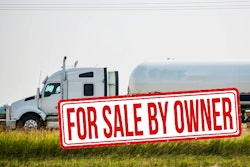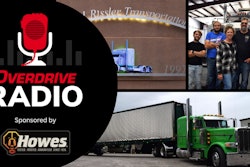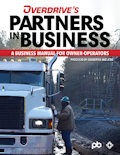
Small trucking companies often operate in extra-competitive markets. There are so many small outfits like yours across the country, depending on the freight niche, and you're competing against them all for work. Standing out is essential.
A few well-placed online assets can help you market your services and engage more clients. You'll get more exposure for your brand and show your audience that you might be a small carrier, but you're professional and reliable enough for big contracts.
I'll show you a few online tools that give you the biggest bang-for-buck so you can fill your schedule without investing too much time. Get more jobs and look more professional -- without endless hours in front of the computer? That’s a load any of us should be able to haul.
Why online presence matters
More and more, customers expect to find you online in a way beyond just an MC# check in the federal system. When they don’t, they're likely to feel unsure about your company. A visible online presence tells clients you’re real, and it gives them a taste of what it would be like to do business with you. Every opportunity you give clients to get to know you makes them feel more familiar with your brand, as I wrote in this prior piece about owner-operator branding basics.

Ultimately, you want a customer to feel like you’re a trusted colleague.
An online presence can help prospecting, too, getting more eyes on your company. You can expand your reach beyond the immediate geographic vicinity and find clients in the friend-of-a-friend who saw your LinkedIn post or the business owner in another state who found your website via an online search.
Key online assets
Whether you have one truck or 20 or more, building an online presence in three key locations will help establish your company as organized and dependable.
Leverage your Google Business Profile. This will be what your customers or prospects see when they turn to Google Maps in search of you or generally for trucking services, especially if they’re targeting a specific geographic area. When they search for “trucking services” or “small truck companies” in your area, a Google Business Profile ensures you’re in the local search results.
To take full advantage, the profile needs to be complete and accurate. That means every section -- from the Overview and list of Services to Photos and the About section -- should be filled and kept up-to-date with correct information. An out-of-service phone number or a broken website link looks amateur and reflects poorly on the business.
Photos of your trucks and/or trailers could help illustrate equipment safety, and offers plenty of branding opportunities, too. Images of yourself and your drivers can showcase a friendly, professional demeanor and help establish trust. “Action shots” of goods being loaded or unloaded, maybe with a happy customer in the shot, are even better.
Advantages of LinkedIn. The LinkedIn social site allows business owners to make connections with customers, but it really shines as an avenue for showing your thought leadership as a small trucking company owner.
Follow prominent trucking voices, join groups like Overdrive's Trucking Pro, and learn what issues are impacting the business. Find others' insights and add your own -- potential and current customers might see you’re knowledgeable about the industry and invested in keeping your trucking practice current.
Make sure your LinkedIn profile looks polished, with a high-quality headshot and banner image (a shot of your truck or fleet would be fantastic) and a well-written bio that describes your services, experience, and company ethos.
When you’re on LinkedIn, you reframe yourself as more than an experienced, trustworthy truck driver -- people will remember that you’re a fellow business owner, too, one who's likely to understand their own business's transport issues and potentially solve them.
Your website: Build it, promote it. Too many small carriers either have a bad website or none at all. They’re missing opportunities, limiting growth by refusing to meet customers where they are -- online.
Think of your website as your digital storefront. It’s often a customer's first impression of your company, and it needs to shine. Include photos and videos of the highest quality you can produce -- visitors love to see real footage of your fleet rather than stock images. Follow the outline we described in our previous story about branding the business to be sure you include the information clients want to read about your company and position yourself in the right light.
Building a website yourself certainly takes more time than positioning your Google Business Profile and LinkedIn presence -- a marketing company like the one I founded can certainly help. If the company has experience working with trucking clients, they’ll be able to help you promote your website, too, to get more visitors that might eventually become customers.
[Related: How to brand your owner-operator trucking business when you don’t own the trailer]
Showcase expertise, follow through
With a few, key online assets in place, boost their effectiveness with “trust indicators” like online reviews. Encourage every customer to leave a review on your Google Business Profile. Potential customers check them, and even if they’re not all 5-star glowing reviews, they can help sell your trucking company.
I know it’s a little uncomfortable to ask, but many customers -- I'd say most, really -- you'll find are more than happy to do it. No matter what they write or how many stars they give you, respond to their review with a "thank you" message. If they have complaints, address them. If they’re full of praise, tell them how glad you are that they liked your service.
Take a few of the best reviews you get and put them on your website, or ask your web developer to install a Google reviews feed on the site so they appear there automatically. You might also ask LinkedIn contacts to review services there and other social media profiles.
Looking perfect in your online reviews is not the goal here -- you want to appear genuine, doing your best to serve the customers.
[Related: Small Fleet Champ assesses growing pains, on location at new company headquarters]
With your online assets up and running, build marketing momentum to stay relevant:
- Post and update regularly. Sporadic updates, or letting your online assets go radio-silent, makes it look like you’ve either gone out of business or are too disorganized to keep up a posting routine. Also: Google and other search engines reward websites with higher rankings when they're regularly updated. Publish a new blog once a month or more frequently. I recommend a goal of 3 LinkedIn posts per week, too.
- Keep your “brand voice” consistent. Strive to sound like yourself, your "brand voice," whether it’s casual and approachable or a little more buttoned up and professional. Use it consistently in all public communications and private interactions, too. People will start to feel like they know and understand your company. Familiarity will make them more likely to turn to you when they need a carrier.
- Digital marketers can help. Companies like mine are here to help if you'd prefer to outsource marketing. It's a good idea, whoever you're working with, to find a company who understands trucking.
Given the bulk of the work of trucking happens in the physical world as opposed to the digital, online might not be your go-to marketing venue, but in today's world it’s essential to establishing credibility. With these few tools and follow-on actions built into your routine, I believe you can make valuable business connections for growth, ultimately, long-term.
 Phillip Atwood
Phillip Atwood
Find more insight around customer outreach, building the business, and more in the "Independence and Growth" section of the Overdrive/ATBS coproduction of the Partners in Business playbook, a comprehensive manual for owner-operator careers. The 2025 PIB edition is newly accessible in this dynamic online content library format.
[Related: Fickle freight on spot load boards won't build the customer base for you]















